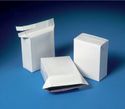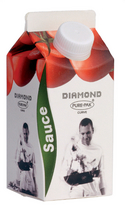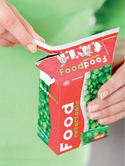Carton appeal expands
14 March 2007Cartons have long been used for milk and fruit juice but are increasingly becoming the solution of choice for a range of other products, as Nessan Cleary reports
For most of us cartons have become an everyday fact of life, with everything from milk and fruit juice to cosmetics and Easter eggs appearing on supermarket shelves in carton form. Cartons offer a number of advantages over other forms of packaging, in that they are relatively cheap to produce and fill, and easy to recycle. In addition, they are lightweight and easily stackable and can come in singles and multipacks, all of which makes them easy to store and transport.
Traditionally cartons have been made from paper or cardboard, which nowadays is produced in sustainable forests. Usually the design for the carton is printed onto the paper, which is then wound through a giant laminating machine which coats it in polyethylene on both sides, making the paper both waterproof and reasonably stiff. This material is suitable for products with a short shelf life and chilled distribution.
Those cartons intended for longer life products also have a layer of aluminium foil added to one side to help prevent light, external aromas and oxygen getting in and spoiling the product. The aluminium layer is encased in a Tie layer, which is then added to the inside of the paperboard layer, and the whole lot sandwiched in between polyethylene layers.
Some manufacturers use EVOH-barrier as an alternative to aluminium where it's necessary to block oxygen but not light from entering the carton.
The next stage is for the paper, still wound on its reel, to be taken to the customer's factory, where it is pulled through a machine into a tube shape. The bottom of the carton is sealed, and the carton filled with the product. Then the top is sealed, and both the top and the bottom are folded into the familiar carton shape.
However, there's more to a longer shelf life than simply adding a layer of aluminium. The whole filling line must be sterilised to enable aseptic filling, which involves heating the product for a second to destroy any micro-organisms that might be present, then sterilising the carton, and filling it under sterile conditions, so that it will last for up to two years.
One of the key issues in cartons today is to expand the options for recycling. Tetra Pak for example, aims to recycle 10%of its cartons and is funding various schemes to achieve this aim, including helping local councils introduce kerbside and “bring-bank” collections targeting cartons.
The vast majority of cartons are used in food products and based around paper, but plastic is also used, with PET a common choice due to its biodegradability, albeit over a period of time. However, most carton manufacturers agree that price is likely to be far more of a driver than environmental concerns, although there is some dispute as to whether or not plastic is cheaper than paper-based cartons.
Alufoil is also becoming increasingly common, with of a growing number of aseptic cartons being used with foodstuffs such as soups. Alufoil is also being used for flexible cartons for products such as petfood, as the packs are cheaper both to manufacture and to transport than traditional tins. Alufoil also lends itself to recycling, being relatively easy to pick out from other waste, and with the recycled alufoil being good enough for re-use in cartoning.
Tetra Pak is one of the pioneers of the use of cartons and produces a number of different versions, including the Tetra Recart said to be the first retortable carton-based processing and packaging system. Able to accommodate particles of almost any size, it is offered as an alternative to cans, jars and pouches, has a rectangular shape for more efficient use of shelf space, is lightweight and fully recyclable. Another of its advantages is said to be its easy opening, with consumers able to unfold it and tear along a perforation. It is currently being used by Sainsbury's for its premium chopped tomatoes, as well as a range of four “tomatoes+” products.
Last year SIG Combibloc introduced a new volume-flexible heat-resistant carton called Combisafe, designed as an alternative to using bottles or tins. This is aimed at the food industry and can be filled with liquids and chunky food products such as vegetables, ready-cooked meals, stews and petfood. The foods are packed and then sterilised in an autoclave, providing for up to two years of storage with no need for preservatives or refrigeration.
The carton is made of cardboard, polypropylene and aluminium, which can be recycled after use. It's printed at the SIG site, before being shipped to customers for filling on equipment supplied by SIG. This uses a proven combination of pumping and pouring technologies and allows for ultrasonic sealing of the carton sleeves after filling, allowing for the safe sealing of chunky products. Each filling machine can run up to four lanes, producing 12,000 pack/hr.
The Combisafe is easy to open thanks to a perforated top which can be folded down after use, allowing part-consumed product to be placed in the refrigerator without risk of cross-contaminating odours. The cartons can hold between 200 and 500ml, with the first customer, German food producer Jutro Konservenfabrik, opting for a 400ml format.
Norwegian company Elopak has a number of innovative carton designs, including its main product, the Pure-Pak carton system, available in standard polyethylene board and an aluboard version for aseptic products, as well as an EVOH board option.
Elopak also produces the Mini Diamond Pure-Pak carton, designed for thicker and richer drinks which can be consumed while on the move. It comes in 250ml, 330ml and 500ml sizes.
There is also a Pure-Pak Curve carton which has a curve moulded into one edge to help it stand out on the shelf from other cartons. This fifth panel also offers an extra space for graphics and product information.
One of the drawbacks in using cartons for foods such as milk and fruit juices is that they can be difficult to reseal and it is becoming increasingly common to find them with plastic closures. Such closures can be tricky, because they are external to the basic cardboard construction of the carton, and so threaten its overall integrity. They also add to costs.
Nonetheless, each carton manufacturer has had to develop its own range of plastic closures. In 1999 Tetra Pak acquired Novembal, a specialist company producing plastic closures for the drinks and dairy industries. Novembal produces a huge range of different caps for cartons, including aseptic systems as well as PET and HDPE bottles, and even synthetic corks.
Tetra also makes a carton with a built-in closure, the Tetra Top, a square carton with rounded corners complete with an injection moulded polyethylene lid which is sealed to the package.
Elopak has its own closure system, Pak-Lok, which comes in two versions. Elo-Cap has been designed for fresh products, with the closure being applied from the inside of the carton through a punched hole before it is filled. The second type, Pure-Cap, is meant for long life and aseptic products, and is applied from the outside, after the carton has been filled, and is lined up with a pre-cut area in the top of the carton. The applicators needed to fit these caps are optional extras which can be retro-fitted to Elopak's filling machines.
Carton machinery
It is vital to consider the machinery in choosing one carton over another, as the equipment will determine what products can be handled and the productivity. Some cartons are sold as a total solution, with a specific machine needed to realise all the features of the carton. Recent years have seen the introduction of servo motors, robotics and programmable changeovers, leading to faster, more robust cartoners, with less maintenance, helping to reduce the overall cost.
Romaco, which specialises in pharmaceutical cartoning machines, launched a new continuous motion horizontal cartoner at the end of last year. The Promatic PC 4300 can produce up to 300 cartons/min, features easily programmable changeovers without any mechanical adjustments and is virtually silent in use. Cartons are supported on combs rather than belts to prevent scuffing. It can handle a range of products, including blisters, bottles, tubes, jars, sachets and vials, thanks to its tailor made feeding systems. A double positive carton opening system featuring a gripper system with independent suction cups increases tolerances in both carton size and quality variation. Later this year Romaco will introduce a 400 carton/min model.
Meanwhile, Bradman Lake has launched a new top load carton system, the Monobloc, designed as a small, affordable solution for the food industry. This is a single unit consisting of three modules, and is capable of forming, filling and closing trays and cartons. The forming component can form cartons from flat blanks, with or without a hinged lid, as well as lock style and four-corner glue cartons, and can open pre-glued cartons. It comes with all the features of Bradman Lakes' AMI Erector, including lightweight carbon fibre lock tools, adjustable flue tools, powered hopper and quick size change abilities.
The loading module has all the agility of the LJ series and comes in single, double or triple race track formats. The closing module uses technology originally developed for the Compact R closer, such as rubber fingers for carton control and quick size change performance. Options include closing of cartons with hinged lid, front flap glue or tuck-in, separated lid and folding or gluing of four upper flaps. All of these units are integrated into a single package, with a common touch panel control point.
Contact details
Bradman Lake Group
T: +44 (0)1603 441000
www.bradmanlake.co.uk
Elopak: +47 31 27 10 00
www.elopak.com
Romaco
T: +44 (0)1480 435 050
www.romaco.com
SIG Combibloc
T: +44 (0)191 385 3131
www.sig.biz
Tetra Pak
T: +44 (0)870 442 6600
www.tetrapak.com







